《英语国家社会与文化入门》课程PPT教学课件(上册)The Society and Culture of Major English-Speaking Countries An Introduction Book 1 Unit 16 Australian Cultural Life
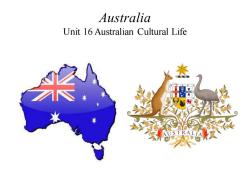
Australia Unit 16 Australian Cultural Life
Australia Unit 16 Australian Cultural Life

Quiz Give the English and a brief explanation for the following: 1.多元文化的 2.救世军 3.现世主义的 4.帕特里克.怀特 5.《辛德勒的名单》
Quiz Give the English and a brief explanation for the following: 1. 多元文化的 2. 救世军 3. 现世主义的 4. 帕特里克﹒怀特 5. 《辛德勒的名单》
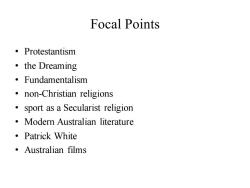
Focal Points ·Protestantism 。the Dreaming 。Fundamentalism non-Christian religions sport as a Secularist religion Modern Australian literature ·Patrick White 。Australian films
Focal Points • Protestantism • the Dreaming • Fundamentalism • non-Christian religions • sport as a Secularist religion • Modern Australian literature • Patrick White • Australian films

This Unit Is Divided into Four Sections I.Religion II.Sport--a Secularist Australian Religion? III.Australian Literature IV.Films
This Unit Is Divided into Four Sections I. Religion II. Sport -- a Secularist Australian Religion? III. Australian Literature IV.Films
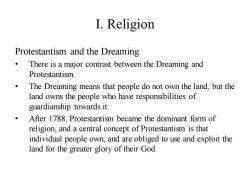
I.Religion Protestantism and the Dreaming 。 There is a major contrast between the Dreaming and Protestantism. The Dreaming means that people do not own the land,but the land owns the people who have responsibilities of guardianship towards it. After 1788,Protestantism became the dominant form of religion,and a central concept of Protestantism is that individual people own,and are obliged to use and exploit the land for the greater glory of their God
I. Religion Protestantism and the Dreaming • There is a major contrast between the Dreaming and Protestantism. • The Dreaming means that people do not own the land, but the land owns the people who have responsibilities of guardianship towards it. • After 1788, Protestantism became the dominant form of religion, and a central concept of Protestantism is that individual people own, and are obliged to use and exploit the land for the greater glory of their God

I.Religion The British brought their form of Protestantism, Anglicanism,to its new colony,and this religious culture supported the values of the new Australian ruling class, the Military and Government leaders,the business owners and large scale agriculturalists of the 19th century.(Right: St John Baptist Church built in 1840s)
I. Religion • The British brought their form of Protestantism, Anglicanism, to its new colony, and this religious culture supported the values of the new Australian ruling class, the Military and Government leaders, the business owners and large scale agriculturalists of the 19th century. (Right: St John Baptist Church built in 1840s)
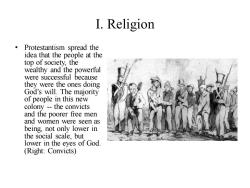
I.Religion Protestantism spread the idea that the people at the top of society,the wealthy and the powerful were successful because they were the ones doing God's will.The majority of people in this new colony --the convicts and the poorer free men and women were seen as being,not only lower in the social scale,but lower in the eyes of God (Right:Convicts)
I. Religion • Protestantism spread the idea that the people at the top of society, the wealthy and the powerful were successful because they were the ones doing God’s will. The majority of people in this new colony -- the convicts and the poorer free men and women were seen as being, not only lower in the social scale, but lower in the eyes of God. (Right: Convicts)
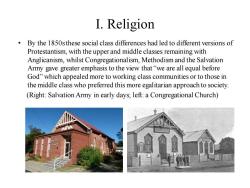
I.Religion By the 1850s these social class differences had led to different versions of Protestantism,with the upper and middle classes remaining with Anglicanism,whilst Congregationalism,Methodism and the Salvation Army gave greater emphasis to the view that"we are all equal before God"which appealed more to working class communities or to those in the middle class who preferred this more egalitarian approach to society. (Right:Salvation Army in early days;left:a Congregational Church)
I. Religion • By the 1850s these social class differences had led to different versions of Protestantism, with the upper and middle classes remaining with Anglicanism, whilst Congregationalism, Methodism and the Salvation Army gave greater emphasis to the view that “we are all equal before God” which appealed more to working class communities or to those in the middle class who preferred this more egalitarian approach to society. (Right: Salvation Army in early days; left: a Congregational Church)
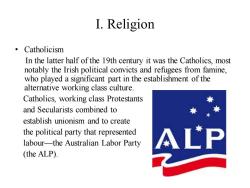
I.Religion ·Catholicism In the latter half of the 19th century it was the Catholics,most notably the Irish political convicts and refugees from famine, who played a significant part in the establishment of the alternative working class culture. Catholics,working class Protestants and Secularists combined to establish unionism and to create the political party that represented labour-the Australian Labor Party ALP (the ALP)
I. Religion • Catholicism In the latter half of the 19th century it was the Catholics, most notably the Irish political convicts and refugees from famine, who played a significant part in the establishment of the alternative working class culture. Catholics, working class Protestants and Secularists combined to establish unionism and to create the political party that represented labour—the Australian Labor Party (the ALP)

I.Religion The Non-Christian Religions-- Buddhism,Islam,Hinduism and Judaism: The histories of Buddhism,Islam and Hinduism in Australia have similar patterns:a modest mid- 19th century growth;a cut back at the beginning of the 20th century due to the racist White australian Policy,and a significant proportional increase when Australia became a multi-cultural society in the 1970s.Buddhism is now the fastest growing belief system in Australia
I. Religion • The Non-Christian Religions-- Buddhism, Islam, Hinduism and Judaism: The histories of Buddhism, Islam and Hinduism in Australia have similar patterns: a modest mid- 19th century growth; a cut back at the beginning of the 20th century due to the racist White Australian Policy, and a significant proportional increase when Australia became a multi-cultural society in the 1970s. Buddhism is now the fastest growing belief system in Australia
按次数下载不扣除下载券;
注册用户24小时内重复下载只扣除一次;
顺序:VIP每日次数-->可用次数-->下载券;
- 《英语国家社会与文化入门》课程PPT教学课件(上册)The Society and Culture of Major English-Speaking Countries An Introduction Book 1 Unit 15 The Land of the Peoples of the Dreaming(Australia).pptx
- 《英语国家社会与文化入门》课程PPT教学课件(上册)The Society and Culture of Major English-Speaking Countries An Introduction Book 1 Unit 14 Irish Culture(Ireland)Language, Literature and Arts.ppt
- 《英语国家社会与文化入门》课程PPT教学课件(上册)The Society and Culture of Major English-Speaking Countries An Introduction Book 1 Unit 13 Irish Culture(Ireland)How the Irish Live Now.ppt
- 《英语国家社会与文化入门》课程PPT教学课件(上册)The Society and Culture of Major English-Speaking Countries An Introduction Book 1 Unit 12 Politics and Economy(Ireland).ppt
- 《英语国家社会与文化入门》课程PPT教学课件(上册)The Society and Culture of Major English-Speaking Countries An Introduction Book 1 Unit 11 Land, People and History of Ireland.ppt
- 《英语国家社会与文化入门》课程PPT教学课件(上册)The Society and Culture of Major English-Speaking Countries An Introduction Book 1 Unit 10 Sports, Holidays and Festivals in Britain.pptx
- 《英语国家社会与文化入门》课程PPT教学课件(上册)The Society and Culture of Major English-Speaking Countries An Introduction Book 1 Unit 09 The British Media.pptx
- 《英语国家社会与文化入门》课程PPT教学课件(上册)The Society and Culture of Major English-Speaking Countries An Introduction Book 1 Unit 08 British Foreign Relations.ppt
- 《英语国家社会与文化入门》课程PPT教学课件(上册)The Society and Culture of Major English-Speaking Countries An Introduction Book 1 Unit 07 British Education System.ppt
- 《英语国家社会与文化入门》课程PPT教学课件(上册)The Society and Culture of Major English-Speaking Countries An Introduction Book 1 Unit 06 British Literature.pptx
- 《英语国家社会与文化入门》课程PPT教学课件(上册)The Society and Culture of Major English-Speaking Countries An Introduction Book 1 Unit 05 The UK Economy.ppt
- 《英语国家社会与文化入门》课程PPT教学课件(上册)The Society and Culture of Major English-Speaking Countries An Introduction Book 1 Unit 04 Politics, Class and Race.ppt
- 《英语国家社会与文化入门》课程PPT教学课件(上册)The Society and Culture of Major English-Speaking Countries An Introduction Book 1 Unit 03 The Government of the United Kingdom.pptx
- 《英语国家社会与文化入门》课程PPT教学课件(上册)The Society and Culture of Major English-Speaking Countries An Introduction Book 1 Unit 02 A Brief Introduction to the United Kingdom Ⅱ.pptx
- 《英语国家社会与文化入门》课程PPT教学课件(上册)The Society and Culture of Major English-Speaking Countries An Introduction Book 1 Unit 01 A Brief Introduction to the United Kingdom Ⅰ.ppt
- 私立华联学院:《英语国家概况》课程教学资源(PPT课件)Chapter Five New Zealand.pptx
- 私立华联学院:《英语国家概况》课程教学资源(PPT课件)Chapter Four Australia.pptx
- 私立华联学院:《英语国家概况》课程教学资源(PPT课件)Chapter Three Canada.pptx
- 私立华联学院:《英语国家概况》课程教学资源(PPT课件)Chapter Two The United States of America.pptx
- 私立华联学院:《英语国家概况》课程教学资源(PPT课件)Chapter One The United Kingdom of Great Britain and Northern Ireland.pptx
- 《英语国家社会与文化入门》课程PPT教学课件(上册)The Society and Culture of Major English-Speaking Countries An Introduction Book 1 Unit 17 Work and Family Life.pptx
- 《英语国家社会与文化入门》课程PPT教学课件(上册)The Society and Culture of Major English-Speaking Countries An Introduction Book 1 Unit 18 Australia as a Liberal Democratic Society.pptx
- 《英语国家社会与文化入门》课程PPT教学课件(上册)The Society and Culture of Major English-Speaking Countries An Introduction Book 1 Unit 19 Australia in the World Today.pptx
- 《英语国家社会与文化入门》课程PPT教学课件(上册)The Society and Culture of Major English-Speaking Countries An Introduction Book 1 Unit 20 From Racism to Multiculturalism.pptx
- 大连理工大学:《英语国家社会与文化》课程教学资源(PPT课件)U1 The United Kingdom of Great Britain and Northern lreland(主编:杨筱霞).pptx
- 大连理工大学:《英语国家社会与文化》课程教学资源(PPT课件)U2 The United States of America.pptx
- 大连理工大学:《英语国家社会与文化》课程教学资源(PPT课件)U3 Canada.pptx
- 大连理工大学:《英语国家社会与文化》课程教学资源(PPT课件)U4 Australia.pptx
- 大连理工大学:《英语国家社会与文化》课程教学资源(PPT课件)U5 New Zealand.pptx
- 大连理工大学:《英语国家社会与文化》课程教学资源(PPT课件)U6 Other English-speaking Countries.pptx
- 大连理工大学:《英语国家社会与文化》课程教学资源(课后练习)英语国家社会与文化 The Society and Culture of English-Speaking Countries(各章答案).docx
- 《英语国家社会与文化入门》课程PPT教学课件(下册)The Society and Culture of Major English-Speaking Countries An Introduction Book 2 Unit 01 Land, People and History of New Zealand.pptx
- 《英语国家社会与文化入门》课程PPT教学课件(下册)The Society and Culture of Major English-Speaking Countries An Introduction Book 2 Unit 10 Social Problems in the United States.pptx
- 《英语国家社会与文化入门》课程PPT教学课件(下册)The Society and Culture of Major English-Speaking Countries An Introduction Book 2 Unit 11 The American Way of Life.pptx
- 《英语国家社会与文化入门》课程PPT教学课件(下册)The Society and Culture of Major English-Speaking Countries An Introduction Book 2 Unit 12 The Women’s Liberation Movement in America.pptx
- 《英语国家社会与文化入门》课程PPT教学课件(下册)The Society and Culture of Major English-Speaking Countries An Introduction Book 2 Unit 13 Technology in America.pptx
- 《英语国家社会与文化入门》课程PPT教学课件(下册)The Society and Culture of Major English-Speaking Countries An Introduction Book 2 Unit 14 Post-WWII American Foreign Policy.pptx
- 《英语国家社会与文化入门》课程PPT教学课件(下册)The Society and Culture of Major English-Speaking Countries An Introduction Book 2 Unit 15 Sports and Scenic Spots in America.pptx
- 《英语国家社会与文化入门》课程PPT教学课件(下册)The Society and Culture of Major English-Speaking Countries An Introduction Book 2 Unit 16 American Popular Culture:Movies and Music.pptx
- 《英语国家社会与文化入门》课程PPT教学课件(下册)The Society and Culture of Major English-Speaking Countries An Introduction Book 2 Unit 17 The Country and its People of Canada.pptx
